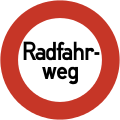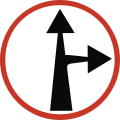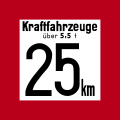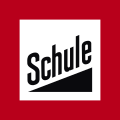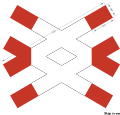Illustration of the traffic signs in the German Reich from 1934 to 1938
The picture table of the traffic signs in the German Reich from 1934 to 1938 shows the traffic signs as they were adopted by the first road traffic regulations of the German Reich , the Reich Road Traffic Regulations (RStVO) of May 28, 1934. This StVO came into force on October 1, 1934. In addition to the traffic signs of the StVO, the traffic-related sign arrangements in the Railway Construction and Operating Regulations (BO) are discussed here.
The 1934 StVO was a completely groundbreaking revision, but it was only granted a short lifespan. It was replaced by another new version as early as 1938. A major concern of the 1934 order with regard to traffic signs was a revision of the older blocking signs, which were not easy to remember and difficult to grasp for motorists.
Colours
The traffic signs were based on the RAL 840 B 2 color card , which had been introduced in June 1932. The following colors were specified in color register 840 B 2 for the traffic signs:
- RAL 6 (red) - RAL 2002 (blood orange)
- RAL 24 (yellow) - RAL 2007 (luminous light orange)
- RAL 32 h (blue) - RAL 5002 (ultramarine blue)
No standard has been defined for black and white, but for orientation it is pointed out that the standard color for white is RAL 1 (RAL 9002 - gray-white) and for black RAL 5 (RAL 9005 - jet black). Since a large number of the characters from that time appeared in enamelled versions, there could be considerable color deviations, since enamel was only defined according to RAL from 1940.
typography
The typographical basis was the standard sheet DIN Vornorm 1451, first presented in 1931 . As a recommendation, it was determined that the fonts contained there should have a minimum line thickness of seven millimeters. Large letters were not less than 50 millimeters high and small letters not less than 35 millimeters high. Exceptions to these regulations have been set out on separate sample sheets. In 1936, the DIN pre-standard was declared the standard in almost unchanged form.
Since typographic characters in particular were often still created by sign painters at that time, there could be significant deviations in the typeface and the expression of individual letters. The same was true for the numbers on the traffic signs. Even the representation in the Reichsgesetzblatt deviates significantly from DIN 1451.
Manufacturing
The signs to be set up had to be lightfast and weatherproof. Reflective, luminous and illuminated traffic signs were allowed.
A. Traffic signs
I. Warning signs
II. Mandatory and prohibitive signs
III. Notice signs
Place-name sign
Signpost for trunk roads. The arrangement of the street number above or below is optional
In 1936 the "trunk roads" were renamed "Reichsstraßen".
Signpost for other paved roads
Sample of the additional attachment of trunk road numbers to curbstones
In 1936 the "trunk roads" were renamed "Reichsstraßen".
Ring road or collection road for long-distance traffic
Main thoroughfare
1st order street
B. The most important in accordance with Article IV of the Introductory Ordinance to the Reich Road Traffic Regulations of May 28, 1934 (Reichsgesetzbl. IS 455) until the new (re A) signs are set up
Blocking signs for permanent blocking
Blocking signs for closures on Sundays and public holidays
speed limit
Speed limit in front of schools and hospitals
Boards that were added to the StVO until 1938 and additional innovations
1935
In the ordinance of September 24, 1935 supplementing the Reich Road Traffic Regulations, special requirements and new warning signs were introduced to mark railway crossings. This new regulation, which came into force on April 1, 1936, did not initially apply to 1st and 2nd order roads. If the prescribed distance of the beacons of 240, 160 and 80 meters could not be observed, the actual distance had to be indicated in black letters above the red bar.
1936
On May 16, 1936, an ordinance was passed to amend the implementation instructions for the Reich Road Traffic Regulations regarding traffic signs . Among other things, the previous long-distance roads were renamed Reichsstraßen and an additional board was introduced on which the respective symbol was displayed in the event of a danger that was repeated in rapid succession (curve or cross channel). In front of this symbol was a number that indicated the amount of the following danger points. In addition, signposts were introduced in front of important junctions and crossings, which could not be smaller than 850 × 1250 millimeters. In addition, it was stipulated that the black road guide lines for the representation of main roads should be 50 millimeters wide and for secondary roads 30 millimeters wide.
Pre-signpost
Additional boards
Additional boards
Regionally prescribed boards
Despite the extensive signage options offered by the new road traffic regulations, regional signs were still set up in particularly endangered places.
Stop signs for postal services
The Reichspost signs, which were inferior to the republican imperial eagle , were produced until 1933 and often remained at their locations after the introduction of newer signs, mostly the walls of public buildings on the rural main roads. After 1933, however, new signs were also produced, now in the new (old) colors of the empire, black-white-red. Both signs became obsolete with the stop signs announced on July 28, 1939 .
Stop sign for Kraftpostlinien
(older sign)Stop sign for Kraftpostlinien
(new sign)
Marks for crossings at rail height
These signs at crossings at rail level were not included in the road traffic regulations. Their arrangement and installation was regulated by the Deutsche Reichsbahn-Gesellschaft, which was placed under Reich sovereignty as the Deutsche Reichsbahn from 1937 .
Warning crosses
The following three characters were first included in 1934 in the sixth ordinance amending the railway building and operating regulations of November 20, 1934. This appeared in the Reichsgesetzblatt , year 1934, part II, pp. 1051-1054 and became legally valid on December 10, 1934.
Warning lights
By decree of the Reich and Prussian Ministry of Transport of December 30, 1935, the warning light systems were recognized and generally approved as equivalent to the barrier. Several models of warning lights were used to secure the unrestricted level crossings.
A slowly flashing white light (45 flashes per minute) meant: The crossing is free for road traffic . A rapidly flashing red light (90 flashes per minute) meant: Stop! The crossing is closed to road traffic . The number of flashes was chosen differently so that color-blind people could also recognize the signal change. The technically most demanding version was intended for multi-track, unbarred level crossings. When two trains approached the crossing from both directions, next to the obligatory red flashing light, the words "Two trains" came on and an alarm clock went off. Paragraphs 79 (1) and 82 of the Railway Building and Operating Regulations govern the use of the signal system. Both the arms of the warning cross and the white-red border of the carrier plate were provided with round reflectors to make the signs even more recognizable for drivers in the dark. The warning lights were operated electrically or, if there was no power supply, with acetylene .
Halt signs
Level crossings were additionally secured near the rail height by white, rectangular warning signs, most of which had a black border. These signs, which were often punched from sheet metal, did not have uniformly regulated labels that were intended to make road users aware of the dangers and / or prohibitions at barrier-free and barrier-free level crossings. It was common to all of these signs that they began with the particularly capitalized word “Halt!”.
Motorway signage
The following characters were not included in the new version and remained largely unchanged in West Germany until the 1956 StVO amendment. The colors of the Reich Road Traffic Regulations were also used for the motorway signs. Usually the large highway panels were made of wood and plywood. They had a white border that could either be painted on or executed as a wooden frame. The letters were painted on or, in some cases, were also made three-dimensional.
From 1937 onwards, the concrete roadways, which had been light up until then, were colored black so as not to provide orientation for enemy aircraft in the event of war. In the same year, plans were also made for the marking of game passes for signposting the motorways. The signage of the deer, roe deer and wild boar was used as an experimental part of the equipping of motorways in 1938. It was hoped that the boards could possibly be dismantled again once the animals had got used to the changes in their habitat and had found new feeding places.
Signpost to the motorway
Boards in the median
Boards on the right edge
As already stated above, in 1938 the signs announcing the passage of game became part of the motorway equipment on an experimental basis. There were two standardized versions of the signs. One symbol showed the outline of a wild boar, the other that of a deer. Depending on the design and accuracy of the sign painter, there could be deviations in the representations. The outlines of the symbols were traced using round reflectors.
Wildwechsel
by deer at 500 meters;
Introduced in 1938Wildwechsel
by wild boars at 1200 meters;
Introduced in 1938
Boards at exits to rest houses
literature
- Dietmar Fack: Automobiles, traffic and education. Motorization and socialization between acceleration and adaptation 1885–1945. Leske + Budrich, Opladen 2000, ISBN 3-8100-2386-8
Web links
Remarks
- ^ Reichs-Straßenverkehrs-Ordinance together with introductory ordinance. In: Reichsgesetzblatt , year 1934, No. 56, date of issue: Berlin, May 30, 1934, p. 455.
- ^ Reichsgesetzblatt , year 1937, No. 56, date of issue: Berlin, November 16, 1937, p. 1190.
- ↑ a b c d Reichsgesetzblatt , year 1934, No. 112, date of issue: Berlin, October 9, 1934, p. 887.
- ↑ a b Johannes Denecke: Lackfarben 1932–1945. In: Johannes Denecke Camouflage paints of the German army 1914 to today , Bernard & Graefe, Bonn 1999, ISBN 3-7637-5990-5 . Pp. 104-106.
- ↑ Commercial legal protection and copyright. Verlag Chemie, Weinheim an der Bergstrasse 1958, p. 444.
- ↑ Circular No. 1/35, January 3, 1935: Proceedings in connection with the redistribution of the road network . In: Die Strasse 1 (1935), pp. 31–32.
- ^ Reichsgesetzblatt , year 1935, No. 104, date of issue: Berlin, September 28, 1935, p. 1181.
- ↑ Ordinance amending the implementation instructions for the Reich Road Traffic Regulations, regarding traffic signs . In: Reichsgesetzblatt , part 1, year 1936, No. 51, date of issue: Berlin, May 29, 1936, pp. 456–458; here: p. 458.
- ↑ Ordinance amending the implementation instructions for the Reich Road Traffic Regulations, regarding traffic signs . In: Reichsgesetzblatt , part 1, year 1936, No. 51, date of issue: Berlin, May 29, 1936, pp. 456–458; here: p. 457. Note: The illustrations in the Reichsgesetzblatt, in particular the representation of the road routing lines, do not correspond to the written specification. The written specifications have been observed in the figures below.
- ^ Order of the Reich Minister of Transport for the introduction of uniform stop signs for trams and motor vehicle lines . From July 19, 1939. In: Reichsverkehrsblatt B, No. 33, from July 29, 1939
- ^ Reichsverordnungsblatt 1, 1936, Issue B, Motor Transport No. 1
- ↑ E. Besser: Lighting technology in railway operations . In: Rudolf Fewig (Ed.): Handbuch der Lichttechnik , Part 1, Springer, Berlin 1938, pp. 881–894; here: p. 893.
- ↑ E. Behr: Securing path crossings at rail height . In: VDI-Zeitschrift , 34 Volume 82, (1939), p. 965 ff .; here: p. 971.
- ↑ E. Behr: Securing path crossings at rail height . In: VDI-Zeitschrift , 34 Volume 82, (1939), p. 965 ff .; here: p. 970.
- ^ Volkhard Stern: Reichsautobahn and Reiseruf - An early telephone service for travelers in motor vehicles. In: The archive. Magazine on postal and telecommunications history. 1, 2008, pp. 28-33; here: p. 28.
- ↑ Files of the Supreme Construction Management of the Reichsautobahn , today Autobahn Directorate South Bavaria : traffic signs, signs, guardrails , Bz. general vol. 4 (1937) as well as traffic sign signature: StAM, Autobahn Directorate Südbayern 351
- ^ Theodor Schattenmann Reichsautobahnen. In: German administration. Organ of the administrative law custodians of the National Socialist Legal Guardian Association. 18th year, issue 15 (1941). P. 287 ff .; here: p. 290.
- ↑ At the entrance curve to the Chiemsee Rasthaus (Autobahn Munich – Salzburg). The layout follows the historical model.














